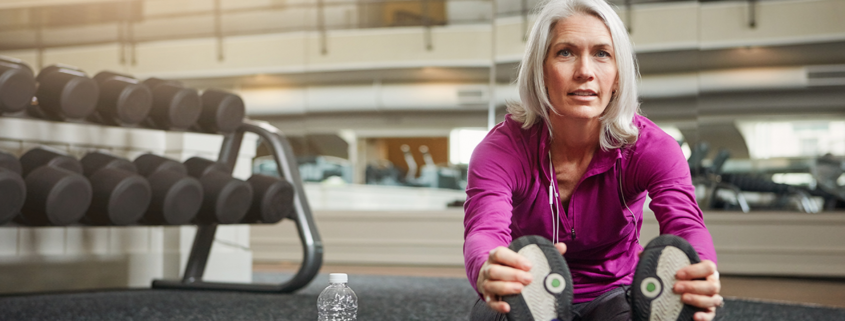Here Are Some Tips for a Pain-Free Exercise Routine
Exercise needs to be a priority for everyone in their 40s, 50s, 60s, and 70s. In fact, one study proved the benefits of strength training for 90-year-olds.
It doesn’t matter if you’ve never exercised, have an existing injury or illness, or lament the days when you were once an accomplished athlete. Exercising three hours per week can increase a person’s lifespan by about five years.
If you already make exercise a priority, you’re in the right mindset. But maybe you’re now experiencing ongoing pain and discomfort while at the gym.
You’ve given up because it hurts too much. But combined with the natural effects of aging, your muscles are getting smaller and your belly bigger.
As you’ll soon learn, there are ways to make gains without the pain. In this post, we’ll give you tips on how to warm-up, exercise, and stretch to decrease the chances of injury or discomfort.
Start with Small Changes
When you were younger, you could walk into the gym, lift 200 lbs or play a game of touch football…even after weeks of sitting on the couch. But now that you’re older, it’s important to start where you are, not where you want to be.
First, don’t try to do everything at once — starting a diet, exercising, and taking supplements. Make small changes so you’ll stick to your goals and decrease the chances of injury or pain.
For example, for one month, commit to exercising three times per week. This could be walking for 30 minutes every evening. And the next month, add in a 30-day diet (one that’s approved by your physician)– you’ll be surprised how easy it’ll be to stick to your new habits after the 30 days are up!
Get a Health Check
Before starting an exercise program or diet, get medical clearance from your doctor. Keep in mind the following:
Some exercises can be harmful or detrimental depending on your condition or current level of activity. For example, abdominal crunches can be risky for people taking heart or hypertension drugs, while Crossfit isn’t appropriate if you have a weak back. Your doctor can advise you on the best program and nutritional plan for you.
Warm-Up Twice As Long
Warming up is a vital part of any exercise routine, and even more important as you age. A dynamic warm-up can improve range of motion in the hips, shoulders, and upper spine. Plus, it reduces the risk of injury and pain while improving your performance. Here’s an example of a dynamic warm-up:
Combine Interval & Strength Training
Most people think endless cardio is the fastest way to lose weight. But doing the same exercise for an hour can hammer your joints. The best approach is high-intensity interval training (HIIT). You perform a movement for 20 seconds on and 10 seconds off.
For example, you squat for 20 seconds and rest for 10 seconds; repeating this for three or so rounds. Here are a few more examples of HIIT workouts.
Water-based HIIT is a big trend this year as it builds muscle strength and endurance while reducing pressure on the joints. Pilates and yoga are also great for strengthening the core and increasing flexibility.
But remember to add weight training into your routine! Doing this will strengthen the muscles that are getting weaker as we age.
Focus on Form
But, don’t load up on weight quickly! Focus on your form to increase mobility and range of motion. Perform high reps with low weight and follow the 10% rule. Only increase your weight by 10% each week to help your body safely adjust to the new load.
Stretch for 10 Minutes After Every Workout
Finally, stretching is incredibly important. It reduces muscle fatigue, increases blood circulation, and aids in injury prevention. Here are a few stretches you should incorporate into every post-workout routine:
Are you ready to start a pain-free exercise routine? Schedule your consultation to learn more about whole body health and treatment.

